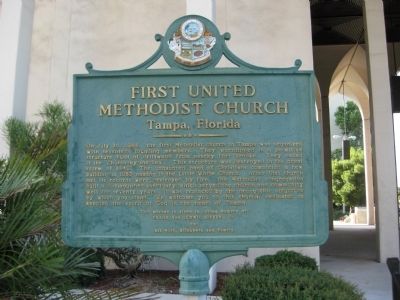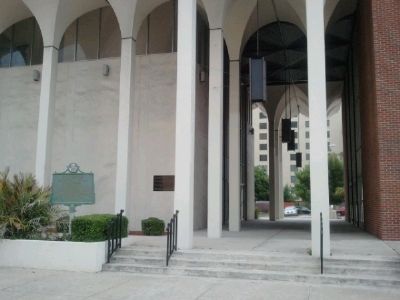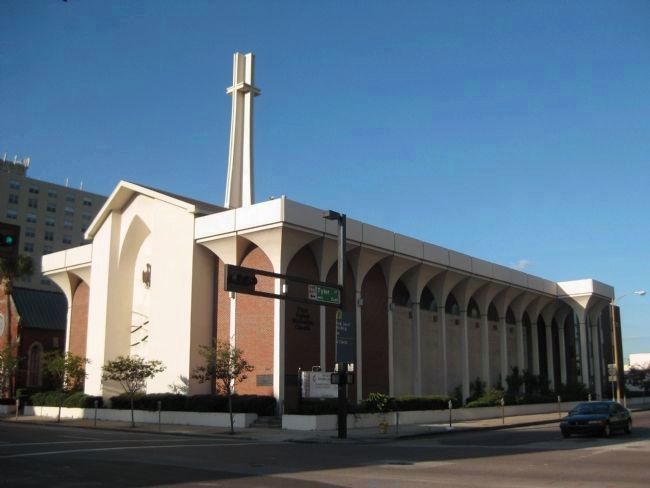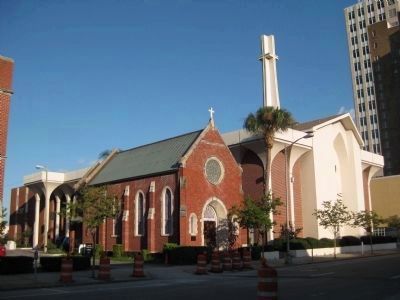Tampa in Hillsborough County, Florida — The American South (South Atlantic)
First United Methodist Church
Tampa, Florida
FRANK Von LUDWIG SIEVER, Jr.
By:
his wife, Elizabeth and Family
Topics. This historical marker is listed in this topic list: Churches & Religion. A significant historical month for this entry is July 1735.
Location. 27° 57.163′ N, 82° 27.517′ W. Marker is in Tampa, Florida, in Hillsborough County. Marker is on East Tyler Street east of North Florida Avenue, on the right when traveling west. The marker is located next to the stairs at the church facility's main entrance. Touch for map. Marker is at or near this postal address: 1001 North Florida Avenue, Tampa FL 33602, United States of America. Touch for directions.
Other nearby markers. At least 8 other markers are within walking distance of this marker. Historic Harlem Academy / School #2 (about 400 feet away, measured in a direct line); Oaklawn and St. Louis Cemetery (about 600 feet away); U.S.S. Sagamore (about 700 feet away); Kennedy (about 700 feet away); Confederate States Soldiers and Sailors (about 700 feet away); Woolworth Sit-In (about 700 feet away); Victims of the Yellow Fever (about 700 feet away); 29 Sea Captains and Mariners (about 700 feet away). Touch for a list and map of all markers in Tampa.
More about this marker. The marker is capped with the crest of the Tampa Historical Society.
Regarding First United Methodist Church. First United Methodist was not just the area's oldest Methodist congregation. When it formed in 1846, it was the first organized church of any denomination or religious faith to come to Tampa. The next church to grace the area, organized by local Baptists, was not established until 1859. Thus, First Methodist, for thirteen years was the only church available to the small community.
It was during this early period that the primitive driftwood structure in which they initially met was lost in a storm, and their more permanent second home, the "Little White Church" was built. Donations were collected to fund the church's construction, and one such donation, a five-dollar gold coin, came from a none other than the future Confederate General, Thomas J. "Stonewall" Jackson, who at the time was a Major in the U.S. Army and stationed at Fort Meade, several miles north of town. With time, sufficient money was gathered, allowing construction of the sanctuary, which stood at the corner of Kennedy and Morgan (eight blocks from this marker). The small structure made from hand-hewn logs and clapboard siding was the first frame church to be built in all of South Florida.
Over succeeding decades, the faithful of First Methodist brought the church through times of extreme hardship such as the Civil War, Reconstruction, and epidemics of Yellow Fever. By the 1890's, however, the arrival of railroads to Tampa brought an end to the city's long isolation, and ushered in a new period of development and opportunity for the area. Now in need of a larger church facility, First Methodist chose to relocate from their earlier property to a site on the northern edge of downtown (the same site where this historical marker now stands). The congregation constructed a stately, new, sanctuary built of brick and stained glass and topped with a soaring spire which could be seen from all
over the city. This, their third new church facility, was one of Tampa's early, significant landmarks. The building remained in use until it was torn down in 1967 due to termite damage, and replaced with the present neo-gothic structure.
From the late 19th century, through most of the 20th, First United Methodist Church played an integral part within the growing community, serving the spiritual and social needs of generations of Tampa's faithful. As the city expanded through the years, the church successful established five new independent Methodist congregations to serve new areas of the city. First Methodist was one of the first organized ministries of charity and assistance to Tampa's hungry, homeless, and needy; and its membership was instrumental in the establishment of many local non-profit assistance agencies and programs, including Meals-on-Wheels, Metro Charities, and the Tampa Children's Home, among others.
By the late 20th century, as Tampa's residents fled its downtown to live in the suburbs, the community surrounding the church was left in decay and the church's prominence began to wane. The congregation experienced a steady decline in membership and saw attendance at church services dwindle away. Ultimately, after several years of uncertainty, the Florida Conference of The United Methodist Church voted in 2011 to discontinue Tampa's First United
Methodist congregation, which held its final service in June. After being a part of Tampa for one hundred sixty-four years, the first church in the city's history is now forever relegated to that history.
Sources: "History of Tampa, Florida".Wikipedia. (http://en.wikipedia.org/wiki/History_of_Tampa,_Florida) • Sprott, Gary (2011-06-05). "Church Closes Doors". The Tampa Tribune. (http://www2.tbo.com/news/community-news/2011/jun/05/MENEWSO3-church-closes-doors-ar-235213/) • Bearden, Michelle (2011-05-29). "Members clash with leadership to keep 164-year-old church open". The Tampa Tribune. (http://www2.tbo.com/lifestyles/faith/2011/may/29/MENEWSO1-members-clash-with-leadership-to-keep-164-ar-233530/)
Related marker. Click here for another marker that is related to this marker. Site of Tampa's First Church Building
Additional keywords. Religion
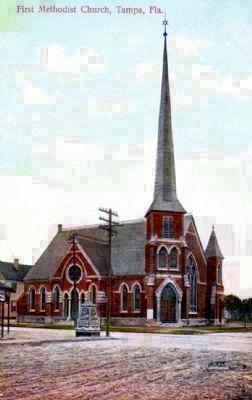
Photographed By International Post Card, circa 1900
5. First Methodist Church, Tampa, Florida
This vintage postcard shows the Methodists' third church facility. The brick sanctuary was the church's home from the 1890's until it was razed 1967 and replaced by the current neo-gothic building. This building is remembered for its enormous spire, which so prominently stood as a pinnacle of Tampa's early 1900's skyline that it played a small role in aviation history. When Tony Jannus in 1914 piloted the world's first commercial airline flight, carrying a single passenger across Tampa Bay from St. Petersburg to Tampa, he used the giant spire atop First Methodist Church to plot his course. Florida Photographic Collection, State Library and Archives of Florida [PC4434]
Credits. This page was last revised on October 15, 2020. It was originally submitted on June 5, 2011, by Glenn Sheffield of Tampa, Florida. This page has been viewed 1,694 times since then and 103 times this year. Photos: 1. submitted on June 5, 2011, by Glenn Sheffield of Tampa, Florida. 2. submitted on June 7, 2011, by Glenn Sheffield of Tampa, Florida. 3, 4. submitted on June 5, 2011, by Glenn Sheffield of Tampa, Florida. 5. submitted on June 6, 2011, by Glenn Sheffield of Tampa, Florida. • Bernard Fisher was the editor who published this page.
